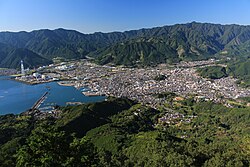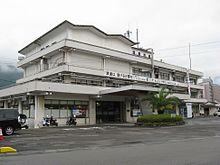Owase
Owase 尾鷲市 | |
|---|---|
 Owase City | |
 | |
 Location of Owase in Mie Prefecture | |
| Coordinates: 34°4′14.8″N 136°11′27.5″E / 34.070778°N 136.190972°E | |
| Country | Japan |
| Region | Kansai |
| Prefecture | Mie |
| Area | |
• Total | 192.71 km2 (74.41 sq mi) |
| Population (August 2021) | |
• Total | 16,910 |
| • Density | 88/km2 (230/sq mi) |
| Time zone | UTC+9 (Japan Standard Time) |
| Phone number | 0597-23-8132 |
| Address | 10-43 Chūōchō, Owase-shi, Mie-ken 519-3696 |
| Climate | Cfa |
| Website | Official website |
| Symbols | |
| Bird | Grey heron |
| Fish | Japanese amberjack |
| Flower | Japanese camellia |
| Tree | Hinoki |

Owase (尾鷲市, Owase-shi) is a city located in Mie Prefecture, Japan. As of 1 August 2021, the city had an estimated population of 16,910, in 9,177 households. The population density was 88 persons per km2.[1] The total area of the city was 192.71 square kilometres (74.41 sq mi).
Geography
Owase is located in southeastern Kii Peninsula, in southern Mie Prefecture, facing the Gulf of Kumano the Pacific Ocean. Ninety percent of the city area is forested or coastal rias. Sandwiched between mountains and the offshore Kuroshio Current, the area has very heavy rainfall from spring through autumn. More than 80% of the population is concentrated in former Osawe town, on the coast.
Neighboring municipalities
Mie Prefecture
Nara Prefecture
Climate
Owase has a humid subtropical climate (Köppen climate classification Cfa). It has comfortable spring and autumn seasons, and warm winters with practically no snow. The warm Kuroshio Current makes its closest contact with the Japanese coast at Owase. Combined with the high mountains falling almost to the sea, this gives Owase an extremely heavy annual rainfall of 3,850 millimetres (150 in), which is the highest in the world at low altitudes in subtropical and warm temperate latitudes.[2] Only certain parts of southern Chile, coastal British Columbia and the Adriatic Sea coast have as much rain at low elevations outside the tropics. Typhoons often pass Owase in summer.
Despite the excessive wetness of the climate, summers are no more uncomfortable or humid than in the rest of southern Japan. Humidity is marginally lower than in the cities close to the Seto Inland Sea or on the southern Sea of Japan.
| Climate data for Owase (1991−2020 normals, extremes 1938−present) | |||||||||||||
|---|---|---|---|---|---|---|---|---|---|---|---|---|---|
| Month | Jan | Feb | Mar | Apr | May | Jun | Jul | Aug | Sep | Oct | Nov | Dec | Year |
| Record high °C (°F) | 22.4 (72.3) |
27.1 (80.8) |
26.5 (79.7) |
30.3 (86.5) |
33.1 (91.6) |
37.3 (99.1) |
38.6 (101.5) |
38.8 (101.8) |
36.6 (97.9) |
31.9 (89.4) |
29.8 (85.6) |
25.6 (78.1) |
38.8 (101.8) |
| Mean daily maximum °C (°F) | 11.5 (52.7) |
12.4 (54.3) |
15.4 (59.7) |
19.7 (67.5) |
23.2 (73.8) |
25.7 (78.3) |
29.6 (85.3) |
30.9 (87.6) |
27.9 (82.2) |
23.4 (74.1) |
18.8 (65.8) |
14.0 (57.2) |
21.0 (69.9) |
| Daily mean °C (°F) | 6.5 (43.7) |
7.2 (45.0) |
10.3 (50.5) |
14.7 (58.5) |
18.7 (65.7) |
21.9 (71.4) |
25.8 (78.4) |
26.8 (80.2) |
23.8 (74.8) |
18.8 (65.8) |
13.7 (56.7) |
8.8 (47.8) |
16.4 (61.5) |
| Mean daily minimum °C (°F) | 2.0 (35.6) |
2.3 (36.1) |
5.3 (41.5) |
9.9 (49.8) |
14.4 (57.9) |
18.6 (65.5) |
22.7 (72.9) |
23.5 (74.3) |
20.4 (68.7) |
14.9 (58.8) |
9.1 (48.4) |
4.2 (39.6) |
12.3 (54.1) |
| Record low °C (°F) | −6.9 (19.6) |
−6.2 (20.8) |
−5.0 (23.0) |
−1.9 (28.6) |
2.8 (37.0) |
8.6 (47.5) |
13.8 (56.8) |
12.6 (54.7) |
9.4 (48.9) |
3.7 (38.7) |
−1.3 (29.7) |
−4.6 (23.7) |
−6.9 (19.6) |
| Average precipitation mm (inches) | 106.0 (4.17) |
118.8 (4.68) |
233.8 (9.20) |
295.4 (11.63) |
360.5 (14.19) |
436.6 (17.19) |
405.2 (15.95) |
427.3 (16.82) |
745.7 (29.36) |
507.6 (19.98) |
211.5 (8.33) |
121.3 (4.78) |
3,969.6 (156.28) |
| Average snowfall cm (inches) | trace | 1 (0.4) |
0 (0) |
0 (0) |
0 (0) |
0 (0) |
0 (0) |
0 (0) |
0 (0) |
0 (0) |
0 (0) |
trace | 1 (0.4) |
| Average precipitation days (≥ 1.0 mm) | 5.6 | 6.6 | 9.5 | 9.8 | 11.0 | 14.6 | 13.0 | 11.7 | 13.9 | 12.0 | 7.3 | 5.9 | 120.9 |
| Average snowy days (≥ 1 cm) | 0.1 | 0.2 | 0 | 0 | 0 | 0 | 0 | 0 | 0 | 0 | 0 | 0.1 | 0.4 |
| Average relative humidity (%) | 60 | 61 | 63 | 68 | 74 | 81 | 82 | 80 | 80 | 76 | 71 | 64 | 72 |
| Mean monthly sunshine hours | 179.8 | 170.5 | 192.9 | 191.0 | 181.7 | 124.2 | 158.6 | 178.4 | 130.5 | 136.3 | 152.6 | 174.5 | 1,965.9 |
| Source: Japan Meteorological Agency[3][4] | |||||||||||||
Demographics
Per Japanese census data,[5] the population of Owase has decreased steadily over the past 50 years.
| Year | Pop. | ±% |
|---|---|---|
| 1920 | 21,672 | — |
| 1930 | 25,522 | +17.8% |
| 1940 | 25,401 | −0.5% |
| 1950 | 31,744 | +25.0% |
| 1960 | 34,534 | +8.8% |
| 1970 | 31,546 | −8.7% |
| 1980 | 31,348 | −0.6% |
| 1990 | 27,114 | −13.5% |
| 2000 | 23,683 | −12.7% |
| 2010 | 20,013 | −15.5% |
History
The area of present-day Owase was part of ancient Shima Province. It was transferred to Kii Province in 1582. During this time, large-scale forestry projects were begun. After the Meiji restoration, the area became part of Mie Prefecture. The town of Owase was established in April 1889, within Kitamuro District of Mie Prefecture, with the creation of the modern municipalities system.
The city of Owase was established in June 1954, by the merger of the town of Owase with the surrounding villages of Sugari and Kuki and the villages of Kitawauchi and Minamiwauchi, both from Minamimuro District.
Government
Owase has a mayor-council form of government with a directly elected mayor and a unicameral city council of 10 members. Owase, collectively with the towns of Kihoku, contributes two members to the Mie Prefectural Assembly. In terms of national politics, the city is part of Mie 4th district of the lower house of the Diet of Japan.
Economy
Owase is mainly supported by its commercial fishery and forestry industries. Yellowtail, amberjack, Japanese horse mackerel, sauries, sea bream and bonito are among the fish landed at Owase. Japanese cypress and cryptomeria trees are found in abundance here in the mountains.
Education
Owase has five public elementary schools and two public middle schools operated by the city government. One public high school is operated by the Mie Prefectural Department of Education. The prefecture operates one special education school for the handicapped.
Transportation
Railway
Highway
Port
- Owase Port
Local attractions
- Kuki (九鬼) - a fishing village
- Kongobu-ji (金剛寺) - Buddhist temple built during the Edo period with two fierce-looking deity statues guarding the entrance. It is located just adjacent to the Owase Jinja.
- Kumano Kodo Centre - Constructed entirely from cypress wood, the Kumano Kodo Centre features the origins and history of the Kumano Kodo pilgrimage route. A playground, also made entirely from cypress, is located near the centre.
- Magose Toge (馬越峠) - a popular hiking trails on the Kumano Kodo - Ise-ji Route. There is a hiking trail which leads to Mt. Tengura, overlooking Owase City. For more information, visit [1]
- Mikisato Beach (三木里ビーチ) - A beautiful white sandy beach, with clear turquoise waters located near the Mikisato train station.
- Nakamurayama Castle (中村山城) - Sengoku period Japanese castle site, now a park.
- Yume Kodo - an onsen located near the Kumano Kodo Centre. The facility features deep sea water onsen, which has healing properties, as well as sauna rooms.
- Owase Jinja (尾鷲神社) - a Shinto shrine noted for an ancient, sacred tree over 1,000 years old and as the venue for the annual Ya Ya Matsuri.
- Sugari (須賀利) - a fishing village located in eastern Owase, best accessed by a 20-minute ferry ride from Owase
Festivals and events
- Itadaki Ichi (イタダキ市) – farmers market held the first Saturday morning of every month, featuring stalls selling Owase's local produce such as fresh seafood, dried fish, sea salt, jam etc. along with special performances by the locals.
- Ya Ya Matsuri (ヤーヤ祭り) – the largest festival in Owase, held annually on 1–5 February. In the evenings of 2-4 February, men parade around the streets, jostling each other and chanting "Ya Ya" while drinking sake before the "chosen" ones dive into the sea to purify themselves. The festival ends off with a day-long street parade on the 5th featuring dance performances and an archery contest at Owase Jinja.
- Owase Minato Matsuri (おわせ港まつり) – a summer festival held on the first Saturday in August with a fireworks display.
- Hachiman Jinja Matsuri (八幡神社例祭) – held on 15 September annually, beginning with a day-long parade culminating at the local Hachiman Jinja
Sister cities
 Prince Rupert, British Columbia, Canada, since September 26, 1968[6]
Prince Rupert, British Columbia, Canada, since September 26, 1968[6] Jinzhou District, Dalian, Liaoning, China, since July 8, 2007[6]
Jinzhou District, Dalian, Liaoning, China, since July 8, 2007[6]
Notable people
- Hideo Fukuyama, professional race car driver
References
- ^ "Owase city official statistics" (in Japanese). Japan.
- ^ Records at Owase observatory, Japan Meteorological Agency (Japanese)
- ^ "平年値(年・月ごとの値)". Japan Meteorological Agency. Retrieved 2010-03-06.
- ^ "観測史上1~10位の値(年間を通じての値)". Japan Meteorological Agency. Retrieved 2010-03-06.
- ^ Owase population statistics
- ^ a b "International Exchange". List of Affiliation Partners within Prefectures. Council of Local Authorities for International Relations (CLAIR). Archived from the original on 5 February 2016. Retrieved 21 November 2015.
External links
![]() Media related to Owase, Mie at Wikimedia Commons
Media related to Owase, Mie at Wikimedia Commons
- Official website (in Japanese)
- Owase sightseeing page (in Japanese)
 Geographic data related to Owase at OpenStreetMap
Geographic data related to Owase at OpenStreetMap



